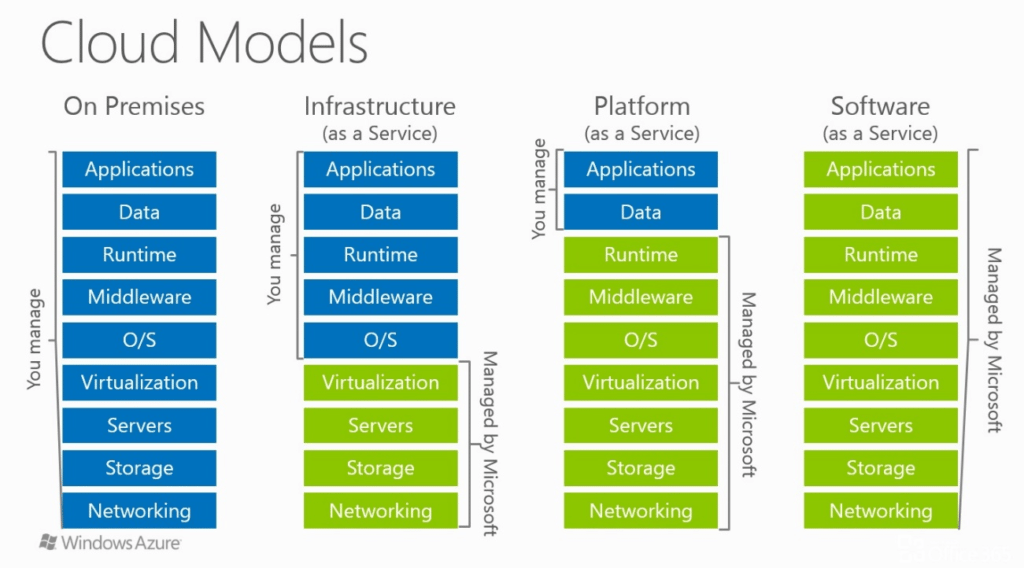

Microsoft Azure
What is Microsoft Azure?
 Microsoft Azure (formerly Windows Azure) is a cloud computing service created by Microsoft for building, testing, deploying, and managing applications and services through Microsoft-managed data centers. It provides software as a service (SaaS), platform as a service (PaaS) and infrastructure as a service (IaaS) and supports many different programming languages, tools and frameworks, including both Microsoft-specific and third-party software and systems.
Microsoft Azure (formerly Windows Azure) is a cloud computing service created by Microsoft for building, testing, deploying, and managing applications and services through Microsoft-managed data centers. It provides software as a service (SaaS), platform as a service (PaaS) and infrastructure as a service (IaaS) and supports many different programming languages, tools and frameworks, including both Microsoft-specific and third-party software and systems.
Azure was announced in October 2008, started with codename "Project Red Dog", and released on February 1, 2010, as "Windows Azure" before being renamed "Microsoft Azure" on March 25, 2014.
Microsoft Azure Product Categories
- AI + Machine Learning: Create the next generation of applications using artificial intelligence capabilities for any developer and any scenario.
- Analytics: Gather, store, process, analyse and visualise data of any variety, volume or velocity.
- Blockchain: Build and manage blockchain based applications with a suite of integrated tools.
- Compute: Access cloud compute capacity and scale on demand – and only pay for the resources you use.
- Containers: Develop and manage your containerised apps faster with integrated tools.
- Databases: Support rapid growth and innovate faster with secure, enterprise-grade and fully managed database services.
- Developer Tools: Build, manage and continuously deliver cloud applications – using any platform or language.
- DevOps: Deliver innovation faster with simple, reliable tools for continuous delivery.
- Hybrid: Get Azure innovation everywhere – bring the agility and innovation of cloud computing to your on-premises workloads.
- Identity: Manage user identities and access to protect against advanced threats across devices, data, apps and infrastructure.
- Integration: Seamlessly integrate on-premises and cloud-based applications, data and processes across your enterprise.
- Internet of Things (IoT): Bring IoT to any device and any platform, without changing your infrastructure.
- Management and Governance: Simplify, automate and optimise the management and compliance of your cloud resources.
- Media: Deliver high-quality video content anywhere, at any time and on any device.
- Migration: Simplify and accelerate your migration to the cloud with guidance, tools and resources.
- Mixed Reality: Blend your physical and digital worlds to create immersive, collaborative experiences.
- Mobile: Build and deploy cross-platform and native apps for any mobile device.
- Networking: Connect cloud and on-premises infrastructure and services, to provide your customers and users with the best possible experience.
- Security: Protect your enterprise from advanced threats across hybrid cloud workloads.
- Storage: Get secure, massively scalable cloud storage for your data, apps and workloads.
- Web: Build, deploy and scale powerful web applications quickly and efficiently.
- Windows Virtual Desktop: The best virtual desktop experience – delivered on Azure.
Microsoft Azure Cloud Service Models
Infrastructure As A Service (IaaS)
The most basic set of services rapidly gaining popularity is the IaaS cloud computing model.
Let’s compare IaaS to traditional on-premises datacenters. With on-premises, it’s your responsibility to manage every component of the datacenter, from business applications to virtual machines and networking.
By using the Azure IaaS service, you’re essentially putting data on a server in the cloud that you can fully control. Maintaining the physical hardware becomes a non-issue because Microsoft takes care of the servers for you. You also don’t have to worry about the expenses associated with failing hard drives and hardware maintenance. What you will have to do is monitor, manage and patch your virtual machines and their operating functions, so it’s still a very hands-on arrangement. In summary, IaaS is the cloud service model that feels like a typical on-premises setup while giving you freedom for running applications you want.

Platform As A Service (PaaS)
PaaS is the next step in cloud service models—it’s the platform on which you roll out your applications. While using PaaS, your responsibility is to manage specific applications and the database, while Microsoft takes care of all other services required to run your application (including middleware, the operating system, VMs, servers, storage and networking). Therefore, responsibility for the success of your application is shared between your organization and Microsoft, with both parties delivering key elements.
A move to PaaS lets you devote more time to developing your application, rather than maintaining the operational functions that support it. Most companies that use PaaS do so because they’re interested in flipping a traditional, monolithic and console-based application (e.g. those that run in a separate console window rather than in a browser, like Word or Outlook,) to a web-based application.
But whether or not you decide to make the move to PaaS you’ll have to consider the required investment. Depending on the size and the complexity of your application, this change may require employing a development team to handle the conversion.
Software As A Service (SaaS)
A SaaS arrangement with Azure handles all infrastructure and IT functions, leaving your SaaS application to run in the cloud on top of Azure. It’s not a platform, it’s an actual application in itself—think Office 365, Salesforce, Basecamp, etc. Everything underneath the application is automated, e.g. patching the VMs.
Your company might consider moving from PaaS to SaaS if you want to be almost completely hands-off. A transition to SaaS may be ideal if your application is highly automated and accessible over the internet, and doesn’t have any lingering dependencies on a specific underlying operating system (OS) or a particular type of middleware. For example, if your application relies on an older OS that isn’t supported in Azure (like any version earlier than Windows 2008 R2), a more complex level of development is required to make the transition from PaaS to SaaS successful.
Select the language of your preference